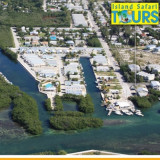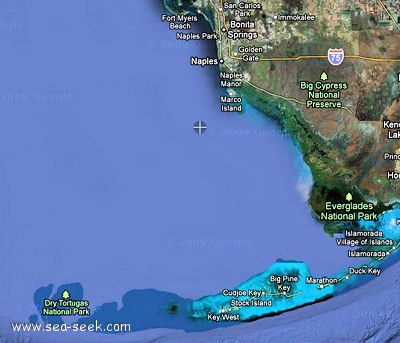

The Keys ( Florida)
Il forme la baie de Floride et s'étend du sud-est de la péninsule de Floride, près de Miami, ...
| Latitude | Longitude | |
| DMS | --- | --- |
| DM | --- | --- |
| DD | --- | --- |


Ebook | Gulf of Mexico
|
 La côte W, sur un peu plus de 200 km, depuis Key West à San Carlos Bay, est peu profonde, sablonneuse, et généralement boisée. De nombreuses petites îles et îlots, parsemés de plusieurs petites rivières forment le Everglades National Park et les "Ten Thousand Islands".
La côte W, sur un peu plus de 200 km, depuis Key West à San Carlos Bay, est peu profonde, sablonneuse, et généralement boisée. De nombreuses petites îles et îlots, parsemés de plusieurs petites rivières forment le Everglades National Park et les "Ten Thousand Islands".Depuis la baie N de San Carlos jusqu'à Tampa Bay, la côte est faite de plages de sable droites ayant pour barrière les îles.
L'extrémité SW de la Floride est la zone des Everglades National Park. La majorité de cette zone est sous l'eau tout au long de l'année et toute recouverte pendant la saison des pluies d'été.
En face des zones de marécage se trouvent les "Ten thousand Islands", un groupe d'îles couvertes de mangrove basse, séparé par des canaux.
Au N des "Ten Thousand Islands" la côte est basse, sablonneuse et généralement bordée de forêts de pins.
De Cap Romano à Anclote Keys la côte devient une barrière d'îles basses séparées par des îlots, dont la plupart sont petits et ne se distinguent pas du large.
Entre Anclote Keys et St James Islands, l'W d'Apalachee Bay, la côte est basse et marécageuse pendant 1 à 2 M et bordée de forêts de pin. La côte est coupée de nombreuses rivières et criques.
Les Florida Keys forment une chaîne d'îles basses le long de la côte SW de la péninsule de Floride, s'étendant en forme de grand arc jusqu'aux Dry Tortugas. Les îlots sont de formation corallienne et sont généralement recouverts de mangroves denses, ou, pour certains de pins ou de cocoteraies.
Florida Keys National Marine Sanctuary est une zone de protection marine (MPA ou ZPM) qui s'étend de Biscayne Bay à Dry Tortugas.
Du côté du détroit des îlots, sur une distance de 5 M, se trouvent les Florida Reefs (Récifs de Florides), de dangereux hauts-fonds qui s'étendent sur toute la longueur de la chaîne. Les récifs sont particulièrement dangereux parce-que on ne les voit pas, même par mauvais temps, peu d'entre eux sont visibles. La profondeur diminue brusquement entre les récifs et le long de leurs bords extérieurs.
Quand on approche des récifs en venant du large, on aperçoit un changement de couleur de l'eau qui passe du bleu profond au vert pâle. Cependant de façon plus technique disons que des profondeurs de 50 m indiquent que vous êtes à 2 ou 3 M des récifs et la prudence est recommandée si vous souhaitez vous approcher de plus près des récifs. Les brouillards sont assez rares dans cette zone.
Les Florida Keys, zone maritime particulièrement sensible (LPFO), on a donc déclaré Zone protégée la zone maritime qui entoure tous les îlots de Floride. Des zones à éviter (ATBAs) on été crée, il en existe 4:
Le long des côtes de Key West à Tampa Bay, les risques majeurs sont les cyclones tropicaux et les fronts froids. Les cyclones tropicaux peuvent se produire à n'importe quel mois, mais représentent une menace surtout en juin, août, septembre, octobre.
Les orages sévissent surtout dans la région de Tampa Bay, sur environ 60 à 80 jours par an, en général de juin à septembre. Ils surviennent au cours de l'après-midi et, en mer, ils se produisent fréquemment la nuit.
Durant l'été, les orages surviennent environ 10 à 20 jours par mois. De l'automne jusqu'au printemps, les fronts orageux ne sont qu'occasionnels, mais rendent une mer agitée avec de fortes rafales de vents pouvant atteindre 28 n?uds ou plus au large de Key West.
La visibilité est en général bonne au large de Key West. Plus au N elle tombe à environ 2 M entre le mois de décembre et le mois d'avril. Le long de la côte le brouillard apparaît mais il se dissipe généralement à l'aube.
 The coast, for nearly 115 miles, from Key West to San Carlos Bay is low, sandy, and generally wooded. Innumerable small islands and keys, interlaced by many small rivers and bayous, make up Everglades National Park and the Ten Thousand Islands. From San Carlos Bay N to Tampa Bay the coast is made up of nearly straight sandy beaches of the barrier islands.
The coast, for nearly 115 miles, from Key West to San Carlos Bay is low, sandy, and generally wooded. Innumerable small islands and keys, interlaced by many small rivers and bayous, make up Everglades National Park and the Ten Thousand Islands. From San Carlos Bay N to Tampa Bay the coast is made up of nearly straight sandy beaches of the barrier islands.The SW extremity of the Florida mainland is part of the Everglades National Park and Big Cypress Swamp. Much of these areas are under water throughout the year and are nearly all covered during the rainy summer season. Fronting the swampy areas are the Ten Thousand Islands, a group of low mangrove-covered islands divided by tidal channels. N of the Ten Thousand Islands the coast is low, sandy, and generally backed by pine forests.
From Cape Romano to Anclote Keys the coast becomes a barrier beach of low islands separated by inlets, most of which are small and cannot be distinguished from offshore.
Between Anclote Keys and St. James Island, the W side of Apalachee Bay, the coast is low and marshy for 1 to 2 miles inland then backed by pine forests. The shoreline is broken by a number of unimportant rivers and creeks.
The Florida Keys comprise a chain of low islands along the SW coast of the Florida Peninsula extending
Win a wide arc to the Dry Tortugas. The keys are mostly of coral formation and are generally covered with dense mangrove, though some have stands of pine and a few have coconut groves. Florida Keys National Marine Sanctuary, a Marine Protected Area (MPA), surrounds the keys from Biscayne Bay to Dry Tortugas.
On the straits side of the keys, and at an average distance of 5 miles, are the Florida Reefs, a dangerous line of shoals which extend along the entire length of the chain. The reefs are particularly hazardous because they do not break in smooth weather and few of them are exposed. The water shoals abruptly between the reefs and along their outer edges.
When approaching the reefs from seaward, their proximity usually is indicated by a change in color of the water from deep blue to light green or by the bank blink, described in chapter 3. However, too much reliance should not be placed on such indications. Lights and daybeacons facilitate navigation along the reefs in clear weather, but soundings should be resorted to in thick weather. Depths of 50 fathoms indicate a distance of 2 to 3 miles from the reefs, and great caution should be used in approaching closer. Fogs are infrequent in this area.
The water always becomes milky following windy weather. The usual color is bluish green on the reefs, while the rock patches are dark, shading through brown to yellow as they approach the surface. Sand patches are bright green. Grass patches at depths of 10 to 15 feet have the appearance of rocks. With the sun astern, the line marking deep water and the edges of reefs is surprisingly clear from a position aloft.
The Florida Keys Particularly Sensitive Sea Area (PSSA) is an IMO-designated zone that encircles the sea area around all of the Florida Keys. The PSSA includes the entire Florida Keys National Marine
Sanctuary as well as Biscayne National Park at the northeastern end of the keys. The PSSA has been established to protect the exceptional values of the sea area around the Florida Keys from possible damage by international shipping activities. The PSSA includes the Tortugas Ecological Reserve, which was established in 2001 to protect nearly pristine coral formations and habitat in the Sanctuary. The coral resources within the Reserve are especially vulnerable to possible damage from shipping activities.
Domestic law and regulations adopted by the United States for the Sanctuary apply within the PSSA.
Several of these concern shipping activities:
Additional restrictions on vessel activities, such as vessel discharges, apply within the Sanctuary.
Along the coast from Key West to Tampa Bay, the major weather hazards include tropical cyclones, thunderstorms, and cold fronts. Tropical cyclones, which can occur in any month, are mainly a threat in June, August, September, and October. Seventeen tropical cyclones have approached the coastline between Key West and Tampa Bay since 1950. The chance of a tropical cyclone encounter decreases along theWcoast, N to Fort Myers and Tampa Bay. Thunderstorms develop on about 60 to 80 days annually along this section of the coast. They are least likely near Key West and most likely in the Tampa Bay area. While they can occur at anytime, they are most likely from June through September, during the late afternoon and evening hours; at sea they frequently occur at night. During the summer months, thunderstorms are observed on about 10 to 20 days per month. From fall through spring, cold fronts occasionally reach these waters generating strong, gusty winds which kick up rough seas. While gales are infrequent, winds of 28 knots or more occur during passage of the front. High winds from the NW precede the front then turn to the North and finally Northeast as the front passes. During the winter, there fronts can occur every week and create problems for boaters that get caught in the Gulf of Mexico as there are few harbors (Tampa Bay, Charlotte Harbor and Ft Myers) that offer protection for transiting boaters. Wave heights of 6 to 10 feet or more are encountered during the passing of a cold front as far south as Cape Romano. Visibilities are usually good, particularly off Key West. Farther N, they drop below 2 miles about 1 percent of the time from December through April. Along the coast, a shallow ground fog may form, but this usually dissipates with the rising sun.






